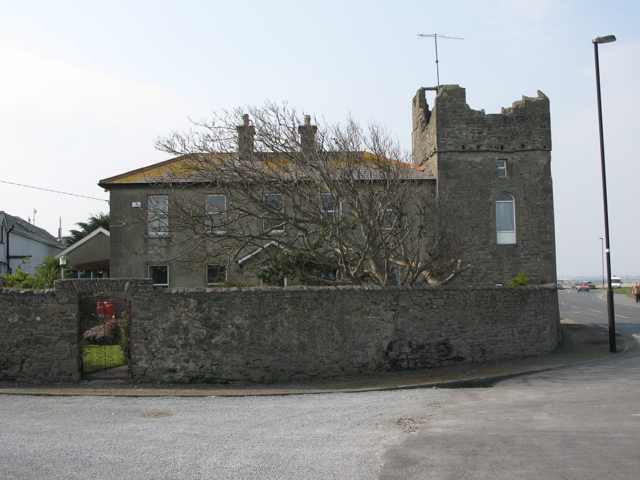
Robswall Castle,County Dublin
Photo © Peter Gerken, 25 March 2007

Robswall Castle,County Dublin
Photo © Peter Gerken, 25
March 2007
This tower house was once occupied by the Cistercian Monks of St. Mary's Abbey,
Dublin and all fishing boats entering the harbour of Malahide gave a donation
of fish to the monks. They also benefited from ship-wrecks. When the monasteries
were suppressed by Henry VIII, he granted Robswalls to his Solicitor-General
for Ireland, Patrick Barnewell C.1540. At one time it had its own small harbour
hewn out of the rocks underneath and had a three-storied circular staircase.
It is minus a storey to-day.
ROBERTSWALL CASTLE,
a square edifice erected on a rock that overhangs the sea, and having a farm-house attached to it. According to tradition this castle was founded in the fifteenth century by one of the sept of de Bermingham.
By inquisition taken in the time of Henry the Eighth, the religious house of the Virgin Mary was found seised of ninety-three acres in "Roebuck's-wall, as also of a castle and six messuages there, annual value £3 13s. 4d. In lieu of which, on the surrender of that house, William Cottrell, "parson of the convent," had a pension of £3 6s. 8d. granted to him, chargeable on the tithes of " Roebuck's walls."
Soon after the dissolution the castle was granted, with its appurtenances, to Sir Patrick Barnewall in fee, which patent was subsequently confirmed by King Edward the Sixth, the premises being charged, as were the manors and lordships of Ballyboghill, Portmarnoek, and the other possessions of Mary's Abbey, with a pension for the last abbot and his brethren. The tithes of Robert's-wall were granted to the same patentee, subject to a yearly rent of £l 10s. Irish, lately purchased by Mr. Christopher Mac Donnell, who has also acquired the fee of the soil.
In 1685, Lord Kingsland passed patent for (inter alia) Robswall, one hundred and fifteen acres, with the tithes thereof.
Lead ore has been found in the rocks here, disposed in ramifications, and crystals resembling Kerry stones have likewise been collected here. It has also a large vein of black and some white marble, with representations of white shells mixed through it, after the manner of the Kilkenny marble.
THE HISTORY OF THE COUNTY OF DUBLIN BY JOHN D'ALTON 1838